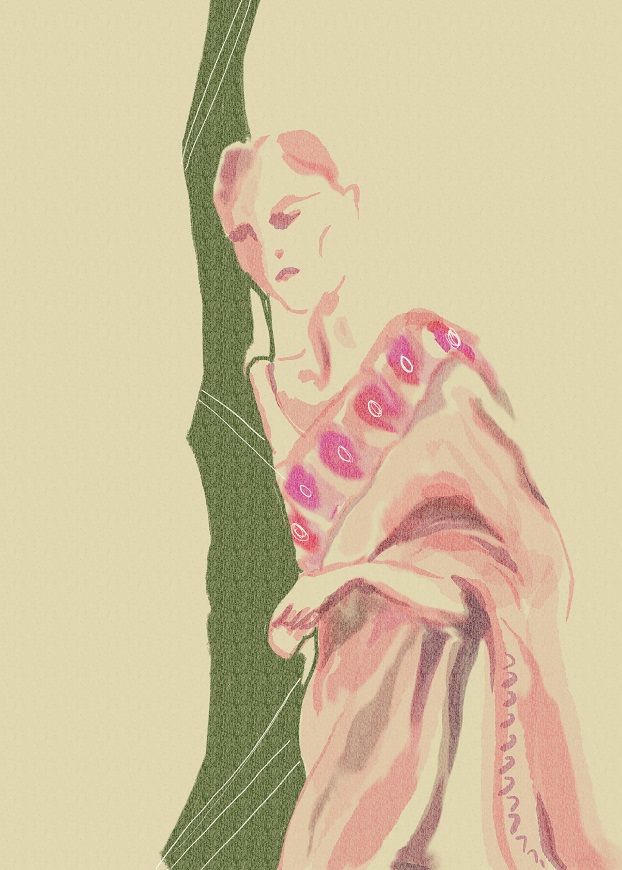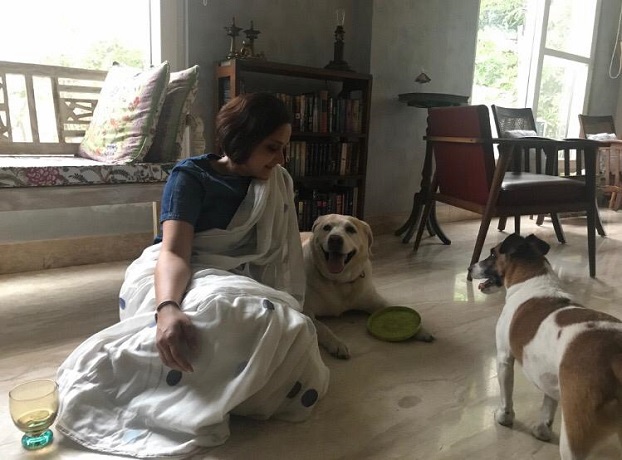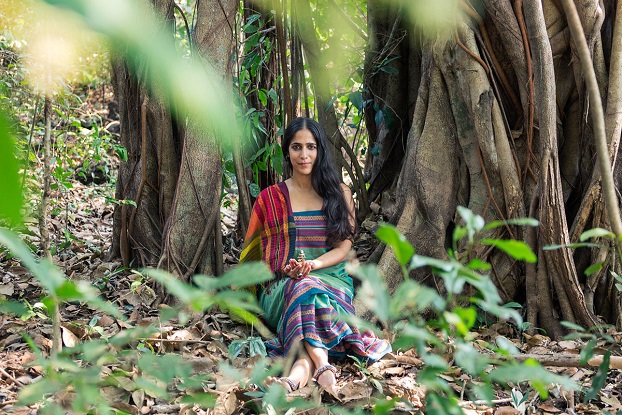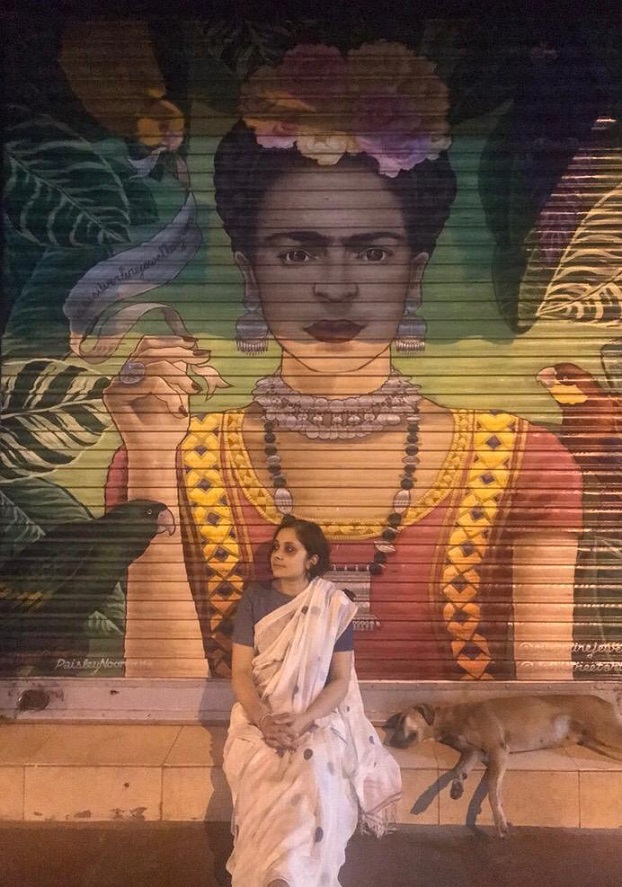How the drape holds meaning and memory for the desi mind, body, and soul. A series of interview-vignettes, showcasing uber serious sari love, brought out via passion, history, politics, through interviews with people across the spectrum who love to drape it, and also, talk about it! Catch up with Chapter One’s interview with impassioned crafts activist Laila Tyabji, Chapter Two’s chat with filmmakers Shabani Hassanwalia and Paromita Vohra, Chapter Three‘s Sari Sisters Jaya and Swaati, and Chapter Four’s focus on politics in the pleats with Sabika and Jasmine. Chapter Five shared a special chat with writer Anuja Chauhan, and Chapter Six a post in the voice of Himanshu Verma, aka Saree Man. And musings from two millennials make for a fun Chapter Seven.

Unfolding “the memory wrap” of the sari with two wordy women of the world. Their travels and their curious eye lend them both a vision that channels itself into images — on the page. Storytellers and mistresses of lyrical verse both, Amruta Patil and Shalini Mukerji share their emotional bond with the drape in question, their words forming sari haikus in my inbox.
Shalini didn’t just grow up wearing them, she grew up “dancing in saris,” she informs us. “Each Durga puja, mummy volunteered my sister and me for the cultural performance at the colony pandaal, and we’d dance in gorgeous lustrous Benarasis that she’d carefully unwrap from their mull-preserve. I remember the sari trunk being the only trunk in the house that didn’t stink of mothballs!” Her equation with the sari, hence, is one of both comfort and glamour. And sheer feminine power.

“Her equation with the sari, hence, is one of both comfort and glamour. And sheer feminine power.”
“Perhaps because we grew up seeing my mom, grandmoms, aunts and their friends going about life in saris with a natural ease, doing the most remarkable things, doing the most ordinary chores — with an easy grace. I’ve seen my nani shoot at thieving red-bottomed monkeys with an airgun in a sari — always on target — and pound away at the typewriter in a sari with the same uninhibited pleasure with which she ate chaat and jalebis. All her life my dadi drew alpanas every evening and tended to plants, dogs and her array of gods in her puja room in spotless white saris embroidered with flowers she’d see around her and stitch — perhaps I’m being fanciful, but I don’t think I ever saw her sari muddied or stained.” Her mum went a few steps ahead, in fact, she tells us, “She even wore a sari for the two years we lived in Scotland and travelled around Europe. She wanted to be recognized as an Indian she would tell anyone who advised that she switch to salwars/pants/dresses. Even after she had a Marilyn Monroe moment with her sari ballooning around her, she continued to wear saris over heels and sneakers, through snow, sleet and rain.”
For Shalini then, there never was any debate around the “relevance or modernity” of the sari. “It never crossed my mind until recently!” she says, semi-aghast, and is wistful already about the “easy, uncomplicated relationship” she had with saris. “Now I’m probably a lot more self-conscious when I wear saris than I was even a few years ago, and I think it’s because sari-wearing is a lot more commented on and so much more of a curiosity. A lot of the times when I reach for a sari, my brain goes into overdrive about the kind of statement I might be perceived to be making. I have found that I pare down my ‘sari look’ — I skip the earrings/bindi/bangle I would ordinarily have worn with even jeans, so I don’t look too dressed up!”

“Minimal but striking tribal jewelry is a staple,” says author-artist Amruta about her sari look, but this is more of a current mood. Unlike Shalini, Amruta’s tryst with the sari did not begin on a joyous note, and she recalls feeling awful through her teens each time she tried wearing it — “It was all wrong between the sari and I for many, many years.” And then, aged 24, the sari made a comeback, and how! It was the opening of her “Draupadi-themed thesis show” and to Amruta, it was nothing short of a reclamation.
“The reclamation sari was red and gold and was the wedding sari of one of the women I love most in the world.” Since then, she has not looked back. Snobby comments have likened her sari look to “kaamwali bai,” but Amruta says simply, as I imagine an eye-roll and a chuckle, “Seriously, who’s the joke on, with that one?”
Today, she makes it a point to wear only saris at international events. “I wear one to almost every formal occasion, especially in Europe, where every inch of my being rebels against being asked to ‘blend in’. This business of blending in is insidious. I wish all immigrants would make the streets pop with their wax prints and turbans and fabrics. Is there not enough grey and black, sartorially and otherwise anyway, in these places?”
Amruta’s love for the drape is almost practical in nature, or perhaps as practical as it is poetic. “Unlike someone’s ballgown or mini skirt or bustier that may or may not be sympathetic, the sari will let you into its story. There has always been so much significance to wearing special person’s sari on a special occasion, a tender continuum of love, rather like the stories passed from storyteller to storyteller in unbroken lineage. The unbroken surface of the fabric lends right into that symbolism.”
“As with language and with human beings, one learns to relax and take a few liberties with apparel one loves.”
And she’s come a long way from that awkward start. “As with language and with human beings, one learns to relax and take a few liberties with apparel one loves. Am doing that with the sari now. I wear certain saris without a petticoat for a snug drape. Have started wearing corsets, knot-up cholis, coatees instead of regular blouses. Also, I occasionally drape the pallu around my neck like a scarf in colder weather.”

Speaking of love, Shalini tells us of the first sari she loved deeply, “a Benarasi of inky-purple and silver bootis gorgeousness like a star-studded sky…” also the first sari she lost, “the zari border got caught in my heel and ripped. It’s probably my first experience of heartbreak.”
But it’s not always all pretty-pretty. Shalini decides to also share with me “that one moment that almost ruined saris for me,” and it stars Shahrukh Khan, “That basketball scene between grown-up Anjali and Rahul in Kuch Kuch Hota Hai, where sari-clad Anjali doesn’t net the ball because her aanchal comes undone and kids in the background erupt into a chant about how girls can’t play basketball! It was like a personal betrayal. Such insidious gender conditioning, probably worse than Honey Singh’s trippy brashness…”
Thankfully, Amruta changes track as she conjures up a sexy vision in response to what she thinks the male counterpart for the sari is. “Men with long, shapely torsos look great in a pathani suit. Turbans, that fantastically ignored drape, needs to be brought back. Ideally with plenty of surma in the eyes.”
She comes from the land of surma-lined men, our next interviewee and the final chapter in Sari Stories. Say hello to Afia Aslam in Chapter Nine.
* * *
Pooja Pande is a writer-editor who grew up in, considers home, and hence has a suitably complex love-hate relationship with the capital city of India, Delhi. Her first book is Red Lipstick, a literary-styled memoir on celebrity transgender rights activist Laxminarayan Tripathi. Find her on Twitter at @derrindo.












